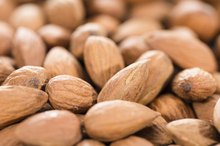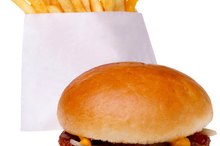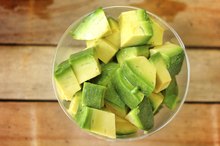Structure of a Triglyceride Molecule
Triglycerides are lipids that circulate in the blood. Triglycerides are fats, and they are used by a cell to produce adenosine triphosphate (ATP), which is the energy currency of a cell. After the body consumes a meal with fats, the unused portions are transported to fat cells and stored as triglycerides. When energy is required by cells, the fat is removed and sent to cells via cholesterol transport.
Structure
The main molecule that starts the structure of a triglyceride is glycerol. Glycerol is a three-carbon molecule with three hydroxyl groups on them. These hydroxyl groups are the site of an ester reaction with three fatty acid molecules. The fatty acids can be different types, and the fatty acid structure defines the type of triglyceride. The fatty acids are long chains of carbons with bonded hydrogens. These are the parts of the triglycerides that are used for energy production.
Types
Components of a Triglyceride
Learn More
Triglyceride fatty acid tails can be saturated or unsaturated. Saturated fatty acid tails are all single bond carbons. This means that for each carbon, there are two hydrogens and two carbons attached. There are no double bonds in a saturated molecule. Unsaturated fatty acids have at least one double bond. Single bond molecules are called monosaturated. A molecule that contains more double bonds is called polyunsaturated.
Bonds
The bonds of the fatty acid chains can be either trans or cis. Media attention has been focused on the dangers of trans fatty acid bonds. These bond types explain how the hydrogens are placed on the molecule in a three-dimensional space. Trans bonds have the hydrogen molecules on opposite sides of the chain. Cis bonds have the hydrogen atoms on the same side of the fatty acid chain.
Function
The Digestive & Circulatory Systems Converting Food Into Energy
Learn More
Triglycerides are mainly circulated in the body to provide cells for energy. However, fats are used for other purposes. Fat supplies cushioned areas for the body's organs to protect them from damage. Triglycerides are also used in the cell membrane to control permeability of the cell. Fats are also used as emulsifying agents like soap.
Considerations
Triglycerides provide a good source of energy, but too much fat can lead to heart disease. Heart disease is caused by the buildup of plaque on the artery walls. This leads to an increase of blood pressure, which puts a strain on the heart. Patients are advised to keep saturated fat intake down. Saturated fats are normally identified as solids at room temperature. Unsaturated fats are liquids at room temperature.
Related Articles
References
Writer Bio
Lysis is the pen name for a former computer programmer and network administrator who now studies biochemistry and biology while ghostwriting for clients. She currently studies health, medicine and autoimmune disorders. Lysis is currently pursuing a Ph.D. in genetic engineering.









